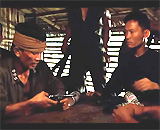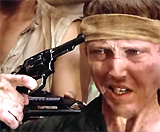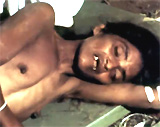
|
Films of All-Time 1978 |

|
The Deer Hunter
(1978)
Storywriter/producer/director Michael Cimino's epic about war and friendship was a powerful, disturbing and compelling look at the Vietnam War through the lives of three blue-collar, Russian-American friends in a small Pennsylvania steel-mill town before, during, and after their service in the war. The three friends were:
Although a Best Picture Oscar-winner, the meandering, sometimes shrill, raw film was extremely controversial on many accounts - political, historical and emotional. The flawed, extravagantly-expensive film was often pretentious, ambiguous, overwrought and excessive, and loosely edited, with under-developed character portrayals and unsophisticated, careless film techniques. Critics argued that the film grossly distorted historical fact. Director Cimino was also criticized as distortedly and one-sidedly portraying all the Asian characters in the film as despicable, sadistic racists and killers. [Note: During the 'Russian Roulette' sequence, none of the words of the Vietcong were subtitled, helping to dehumanize them.] He countered by arguing that his film was not political, polemical, literally accurate, or posturing for any particular point of view. During an interview, Cimino allegedly claimed that he had Singapore news clippings that confirmed Russian roulette existed during the war, but they were never conclusively identified. Cimino's successful epic led to further films in Hollywood - mostly box-office failures, including the excessive and costly Heaven's Gate (1980) - a film that virtually bankrupted its studio, United Artists. The most talked about sequences in The Deer Hunter were the contrived, theatrical, and fictional Russian Roulette tortures, imposed twice in the narrative - (1) on the American POW's during wartime, and (2) played as a game in a Vietnamese gambling den.
Historically inaccurate or not, the fabricated scene of a Vietcong atrocity metaphorically depicted the brutal absurdity of the war. (1) The first controversial, shocking, draining and
horrifying Russian Roulette sequence (approximately 20 minutes in
length) occurred when
three buddies in the Vietnam War from the same town, Michael Steven and Nick were captured as POWs
of the Viet Cong, and held in a riverside pontoon hut. The poorly-fed,
beaten prisoners were placed in a bamboo pit (a tiger cage) half-submerged
in the corpse-, disease- and rat-infested water, and in a similar
enclosed, bamboo cage under the command shack. The gun barrel's loaded cylinder, with one bullet in the chamber [the noble 'one-shot' philosophy carried to its utmost extreme] was spun to a random position. Something in Steven snapped as he waited below and heard others tortured and killed point-blank by their own hand. Blood spurted from the head of an unlucky participant and ran down from above onto the awaiting contestants. When it was Michael's and Steven's fateful turn to play the deadly game, Michael bravely urged and consoled an hysterical Steven to pull the trigger, while the foreign tormentors barked unintelligible orders at them. When Steven finally fired, a bullet was released, but because of the angle of the gun barrel and the position of his quivering hand, it only grazed the side of his head. The Viet Cong enjoyed the sport, laughing at Steven's failed attempt and punishing him by dragging him to the pit to experience a torturous death in water up to his neck. Released for a short while, Michael expressed fears to Nick that Steven wouldn't make it, but Nick recoiled at him: "What do you think you are, God?" Michael devised a crafty plan for escape - he suicidally suggested raising the odds against his own survival: "We gotta play with more bullets...That means we gotta play each other...You gotta listen to me. You wanta stay down here and die?" The pals became the next two players and Michael urged Nick to pull the trigger: "Go ahead Nickie. It's gonna be all right." But when Nick balked, Michael convinced the evil game-leader to let them wager on three bullets in the gun (cutting their odds of survival to 50-50), and assured Nick: "Don't worry, in five minutes we're gonna be outta here." (The ever-calculating Michael realized that the bullets loaded into the gun's chamber were side-by-side, increasing their chances of survival.) When the gun was spun and pointed toward Michael, it was his turn. In a show of bravado, he laughed and doggedly proceeded to play, with a blank click against his own temple. When it was Nick's turn again, Michael encouraged him not to crack under the intense pressure: "It's gonna be all right, Nickie, go ahead. Shoot. Shoot, Nickie." After some delay, the gun miraculously clicked on an empty chamber a second time. On the third time around, a steely-eyed Michael abruptly and swiftly swung the gun from his own temple toward the sadistic leader and shot him square in the middle of his forehead. They both grabbed rifles from the other surprised gamblers and strafed them with gun-fire. Michael subdued Nick as he senselessly sought revenge and repeatedly beat in the head of one of the guards with a rifle butt. They escaped and fled from their floating prison after freeing Steven from his watery grave. (2) The additional sequence later in a smoke-filled Saigon gambling den where the lethal game of Russian roulette for money was actively flourishing and led by a one-eyed referee. Michael winced as one of the young, red head-banded contestants blew his brains out. He saw his friend Nick, addicted to the game, arriving to be the next player. He had become dehumanized by his war experience, was glassy-eyed, drugged-out, and heroin-addicted, and constantly playing Russian roulette for high stakes in the gambling casinos. Frustrated, Michael pleaded with Nick to leave ("I came 12,000 miles back here to get you...Don't do it! What's the matter with you? Don't you recognize me? Huh?...Nicky, I love you, you're my friend. What are you doing?"), but his automaton-zombie friend didn't recognize him. Michael daringly took another approach (to "play the American") - he bought himself into the game (with some of his own cash and some from the cynical Frenchman Julien's (Pierre Segul) bribe money) - risking suicide so that he could save Nick. The gambling crowd reached a howling, fever pitch when the two Caucasians faced opposite each other at the Russian roulette table, once again reunited. Trying to shock his friend into recognition - by recalling their time together in the POW shack, Michael begged Nick to leave with him: "We don't have much time, Nick." Nick took the gun - with one bullet, and pointed it threateningly at his temple, but there was no bullet. After being handed the gun for his turn, Michael asked rhetorically: "Is this what you want? Is this what you want? I love you, Nick." As he cocked and pulled the trigger, he also survived the first round, relieved that he was still alive. There had been a faint flicker of recognition on Nick's face, and Michael pleaded: "Come on, Nicky, come home. Just come home. Home. Talk to me." Michael delayed the game by grabbing his friend's hand that already clenched the gun for the second round, asking: "What did you do to your arms?" There were scars of needle-tracks up Nick's arm - and emotional scars too deep to reach, although Michael attempted to break through one last persuasive time:
Nick remembered Michael's hunting credo, but it was too late to save him. Nick blew his brains out with the next shot - one shot, living out the logical consequence of the code. The "one shot" hunting theme and the deadly Russian roulette gamble were tragically echoed in the death of Nick. Michael's mission to bring Nick home alive had failed. It was Nick's last fateful game. As blood spurted from his friend's temple, a grief-stricken Michael was emotionally devastated and agonized over Nick's death. Howling with grief, he cradled his pal's bloodied head, pleading for him not to die: "Nicky, Nicky, don't, Nick, no!!" |
  Steven      Michael   Nick   "Russian Roulette" Sequence With VietCong as POWs  Escape       "Russian Roulette" in Saigon Gambling Den |
||||||||||||||||||||||||

|
Faces of Death (1978) (aka The Original Faces of Death) This dark horror mondo-type shockumentary film from writer/director John Alan Schwartz, a recognized cult film, was a gimmicky, semi- faked compilation of 'faces of death' and was a huge success on home video in the late 70s and early 80s. It was inspired by the earlier similar film, Death: The Ultimate Mystery (1975). The 'documentary' film was originally financed by Japanese producers for a theatrical run in 1979 or 1980 (and was originally titled Junk), and only later became a success in the US during its home video release. The video box displayed a white skull on a black background, with the statement (most probably an exaggeration):
Two scenes of animal cruelty were actually cut from the film, to satisfy British censors - although censors didn't realize both scenes were faked!:
The sensationalist, 'forbidden' or even 'illegal' film pales in comparision, however, to present-day cable-TV images, the Internet and 'real horror' news footage. About half of the film was composed of real footage, while the remainder was stock footage or blatantly re-enacted (staged) incidents. The compilation surveyed animal violence, abuse, and cruelty, and then human death and suffering. Sequels followed with numbered supplements:
It first began with a failed open-heart surgery when the patient died ("In one brief moment, in the span of a heartbeat, your world could stop. There is no way to predict when you will become one of them"), followed by examples of corpses in a morgue readied for graphic autopsies during the titles sequence. The main character was introduced as he emerged from the morgue to remove his bloody latex gloves and white smock - narrator and self-proclaimed pathologist Dr. Francis Gross (who claimed to have traveled around the world to complete research because of his compulsive need for an "understanding of death" - to gain "a new perspective from the many faces of death") - a parody of a mad scientist. He said he wanted 'to look at man's morality and the mysteries and rites surrounding death," because we have developed "a world that refuses to recognize our own destiny." He described how he had a recurring dream of a funeral (with only two characters, a female in a coffin and a priest) ("with constant images of death"). Real footage from around the globe (of death) included:
Then came the infamous monkey hammer-bashing and brain-eating sequence in an exotic middle-eastern, Egyptian restaurant (the sequence was reportedly faked in a Moroccan US restaurant, but based upon actual practices). A model monkey with a breakaway head was hit by a foam mallet - and blood-red-colored cauliflower for brains substituted for the real thing.
Next followed shark fishing, the clubbing of seals in Alaska ("The only thing I question is their method of death. Whether or not the seal feels any pain is purely a matter of conjection"), illegal alligator harvesting, and a re-enacted (staged) alligator attack on a Florida game warden ("his mutilated body represented a violent retaliation from a creature which has suffered continual abuse from mankind"). The remaining portion of the film included:
Dr. Gross ended the film with these thoughts after examining the 'ghost' case:
The film ended with a woman pained in childbirth, and her joy at hearing her baby's first cries. The song "Life" (music by Gene Kauer, and lyrics by Jerry Winn) played during the film's scrolling end titles. |
 Open Heart Surgery  Corpse in Morgue   Autopsy (During Title Credits)  Narrator Dr. Francis Gross  Bloody Dogfight  Rooster Head-Chopping  Slaughterhouse  Clubbing of Seals  Police Shoot-Out  Bloody Crime Scene  Body in LA Morgue   SF Flesh-Eating Cult of Immortality and Orgy of Blood  Kentucky Religious Cult of Snake Handlers  Vacationer Photographing Grizzly Bear  Holocaust Images  Cholera Victim in India  San Diego Plane Crash  Dr. Gross' Final Words |
||||||||||||||||||||||||

|
I Spit On Your Grave (1978) (aka Day of the Woman)
This exploitative, low-budget X-rated (later released in an R-rated version although of the same length) notorious gang rape/vigilante revenge splatter-horror film was banned outright in many countries, and vilified by critics. Its uncompromising theme of violent vengeance placed it in the category of filthy and debased exploitation film (masquerading as an anti-rape diatribe), and reviewers such as Ebert and Siskel (who described the unrated version as vile garbage) attempted to have the film pulled from theaters. Other similar films of revenge preceded it, such as Straw Dogs (1971) and Wes Craven's The Last House on the Left (1972). Its director defended the film as evidence of triumphant female empowerment as seen by the film's conclusion, although most of the film depicted prolonged multiple rapes by backwoods hicks upon the city girl. The story followed Jennifer Hills (Camille Keaton, grand-niece of comedian Buster Keaton, and married to director/writer/producer Meir Zarchi at the time of filming). She was an aspiring novelist and NYC short story writer (of articles published in women's magazines) who had rented a remote and woodsy, upstate NY riverside dwelling for the summer (the film was made in rural Connecticut), to write her first novel. When she first arrived at the house, she went skinny-dipping. She had a passing acquaintance with four misogynistic locals when she arrived: three were aimless and sex-obsessed guys at a gas station:
Next, there were two entirely painful-to-watch rape sequences that were graphic and lengthy (30 minutes in a 100 minute film!), one in the muddy forest, and another in her house. One day while she was sunning herself in a canoe on the river, two of the men from town Johnny and Andy circled her in their motorboat, and towed her canoe to shore where they harrassed her and chased her through a muddy forest. They were met by the two others - the excuse to hassle her was to aid Matthew in losing his virginity to her ("The broad's all yours. Come on....We got her for you"). So they stripped her of her bathing suit and offered her up, but when Matthew chickened out ("I can't do it now, not now!"), Johnny raped her in a meadow in degrading fashion. She vainly struggled against them as she was held down and violated. She crawled away and ran off, only to be tracked down again by harmonica-playing Andy - and then brutally and anally raped by Andy while restrained over a large boulder - and letting out a horrendous scream! Her experience was particularly heinous, including both a vaginal and anal rape in the outdoors.
Almost immediately thereafter before she could call the police, there was a second rape assault in her rental house by an impotent, slightly-drunken Matthew. He complained to his buddies: "I can't come, you're interrupting my concentration...I can't, not with people watching me." As Jennifer laid there helpless, Stanley told her: "Total submission. That's what I like in a woman. Total submission," then briefly bottle-raped her and thrust his crotch into her face, yelling: "Suck it, bitch!" as he repeatedly slapped her and called her a whore. When ordered and coaxed into stabbing Jennifer to death in the heart to eliminate their only witness to the multiple crimes ("If she's dead, she can't point her finger at us"), Matthew faked the murder by spreading blood on the knife blade.
Bruised and battered, the traumatized victim Jennifer knelt under a cleansing shower. Two weeks later after Jennifer was spotted on the lawn by the river, Matthew was beaten up for lying. Afterwards, she visited a church and prayed for forgiveness (while vowing to seek revenge) before the brutal and bloody counter-assault she had planned, followed by the scenes of her angry revenge against each of the four attackers. Two of the killings involved sexually seducing and distracting the men beforehand, in order to lower their defenses:
|
 Jennifer Hills (Camille Keaton)  Jennifer: Skinny-Dipping  Cleansing Shower after Rapes  Visit to Church       Seduction of Matthew Before Hanging Him       Vengeful Castration of Johnny   Andy Axed in Back  Stanley Disemboweled by Motorboat |
||||||||||||||||||||||||

|
Pretty Baby (1978)
Louis Malle's provocative R-rated American debut film - a semi-scandalous picture upon its release, was criticized for being child porn. It debuted at a time when there was public uproar over child abuse, child pornography, and child prostitution. Malle had hired a female scriptwriter (Polly Platt) to insure that the film was dealt with in a sensitive manner. Some worried that young Brooke Shields would be traumatized by her 'adult' role in the film - yet the entire film was basically free of explicit scenes or language. Today, the historical drama would be considered fairly tame. However, the film was banned in various countries, or censored versions were the only ones allowed. Various versions were edited (with dark shading, readjusted formats or closeups), and a G-string shield was worn to avoid portraying the underage nudity of the budding, prepubescent Brooke Shields. Two scenes of Shields' nudity were removed from some versions of the film in various countries. Some critics recognized that the film possibly portrayed Brooke Shields as a defenseless and naive daughter used by her manipulative mother - similar to her publicity-fueled image in real-life. The fictional yet historically-inspired drama was based on Al Rose's 1974 non-fictional book Storyville, New Orleans: Being an Authentic, Illustrated Account of the Notorious Red-Light District. The tagline described the film's point of view:
It was gorgeously photographed by Bergman-cinematographer Sven Nykvist, and realistically set in a 1917 New Orleans bordello in the legalized red-light district of Storyville during the Great War. Customers were entertained with ragtime music in the brothel by cathouse piano player "The Professor" (Antonio Vargas). The erotic, slice-of-life drama told the plodding, tragic coming-of-age story of a virginal, jaded 12 year-old Violet (former child model Brooke Shields in her breakthrough role) - a pre-teen child prostitute who lived with her languid New Orleans brothel mother Hattie (Susan Sarandon). Ernest J. Bellocq (Keith Carradine) often frequented the bordellos to photograph the working girls. During one of Bellocq's photo sessions with Hattie (while Violet watched inquisitively), she bragged about her body:
Bellocq requested that she sprinkle white powder on her shoulder and her exposed breast. Hattie dusted herself, and then provocatively wiped the powder from her nipple with a moistened finger. Violet attended the entire shooting, and was accused of getting in the way of the day's work by Bellocq.
Once Violet turned 12, the brothel madam - cocaine-sniffing Madam Nell (Frances Faye) encouraged brothel patrons to bid in an auction for the matter-of-fact honor of taking Violet's virginity ("Remember, gentlemen, she's as fresh as a baby's lips"). Violet's first night as a prostitute went to the highest bidder ($400 cash). After Violet's deflowering, the buyer (Don Lutenbacher) scurried off and left Violet lying motionless and quiet on an upstairs bed. Everyone rushed in with worry: ("Get a doctor! She's been murdered!"), but after a long delay, Violet stirred and rebuked everyone by joking: "Well, I'd like to know where the hell y'all been? I been lying here forever! You don't care about me at all." However, she did wince when she sat up - evidence that the experience was painful. Later, in one of the film's more contested scenes, Madam Nell offered the naked Violet in her bath to a dumb-founded farmer - a prospective customer:
To better herself and become more respectable, Hattie decided to marry one of her rich clients, Mr. Alfred Fuller (Don Hood) and move to St. Louis. Violet refused to go with her mother, and Hattie gave her future husband the impression that Violet was her younger sister, not her daughter! As Hattie left, she promised to return at some time to retrieve Violet (once she told her husband the truth). In the meantime, the abandoned (or deserted), coquettish and headstrong Violet (after a run-in with Madam Nell) decided to move in with Bellocq to get away from the brothel. Bellocq took the young girl into his residence - signifying the complete loss of her innocence. At one point earlier, Violet naively told him: "I love you once, I love you twice, I love you more than red beans and rice!" Their relationship (with such an age gap) was highly unusual and often contentious, more like a squabbling parent-child. In one sequence, when Violet reclined for a long period of time on a chaise lounger as the obsessed and voyeuristic Bellocq fiddled with his camera for more picture-taking of his nude model (similar to sessions with her mother), the very childish Violet became restless, irritable, and frustrated. She lept up and approached the camera angrily and rebelliously:
To spite him, she smashed a photographic plate and scratched out the image on another. He viciously slapped her across the face, ordered her out of his house, and locked her in one of the rooms - treating her like a child:
After quarreling with Bellocq, Violet returned to the brothel although by now, the Storyville brothels were no longer legal and were closing down. Violet had little choice, now abandoned, but to marry Bellocq. A license was acquired before a judge and the ceremony was officiated in a church. Two weeks later, Hattie arrived to take back Violet, when she unexpectedly arrived from St. Louis with her new husband Mr. Fuller, a pavement contractor. She claimed: "I told him all about you, Violet, and he insisted that we come and get ya....And he wants you to come home with us." The marriage was considered illegal and null at her age, without Hattie's consent: "It is not legal without my consent." Mr. Fuller argued that Violet would thrive with a more conventional and proper life and a chance at being schooled:
Although Bellocq was adamant and refused: "Well, you cannot take her! I can't live without her... that's all," he had no choice in the matter, and neither did Violet. At the train station before departure, Mr. Fuller took a few family snapshots - the last film image was an ambiguous freeze-framed image of Violet - not really a child anymore. |
 Pretty Baby (Brooke Shields)  Frequest Brothel Visitor: Photographer Ernest Bellocq (Keith Carradine)  One of Bellocq's Actual Turn-of-the-Century Portraits  Brothel Madam Nell (Frances Faye)  Bidding on Violet During Auction  After Deflowering: "Where the hell y'all been?"  (l to r): Violet and Her Mother Hattie - Who Wished to Leave the Brothel  Violet to Bellocq: "I love you once, I love you twice, I love you more than beans and rice"   Violet (Brooke Shields) with Photographer-Husband Ernest Bellocq (Keith Carradine)   Marriage to Bellocq  Hattie's Return to Take Violet  Family Picture at the Train Station  Film's Final Ambiguous Freeze-Framed Close-Up of Violet |
||||||||||||||||||||||||
(chronologically, by film title) Intro | Silents-1930s | 1940s-1950s | 1960-1961 | 1962-1967 | 1968-1969 1970-1971 | 1972 | 1973-1974 | 1975 | 1976-1977 | 1978 | 1979 1980-1982 | 1983-1986 | 1987-1989 | 1990-1992 | 1993-1995 | 1996-1999 2000-2002 | 2003-2005 | 2006-2009 | 2010-present |